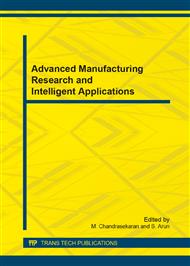[1]
S. A. Taplidou, L. J. Hadjileontiadis, Wheeze detection based on time-frequency analysis of breath sounds, Computers in biology and medicine, 37(8), 1073-1083 (2007).
DOI: 10.1016/j.compbiomed.2006.09.007
Google Scholar
[2]
S. S. Alsmadi, Y. P. Kahya, Online classification of lung sounds using DSP, Proceedings of the Second Joint in Engineering in Medicine and Biology, 2, 1771-1772 (2002).
DOI: 10.1109/iembs.2002.1106645
Google Scholar
[3]
R. Jané, D. Salvatella, J. A. Fiz, J. Morera, Spectral analysis of respiratory sounds to assess bronchodilator effect in asthmatic patients, Proceedings of the 20th Annual International Conference of the IEEE in Engineering in Medicine and Biology Society, 3203-3206 (1998).
DOI: 10.1109/iembs.1998.746175
Google Scholar
[4]
E. Ç. Güler, B. Sankur, Y. P. Kahya, S. Raudys, Two-stage classification of respiratory sound patterns, Computers in Biology and Medicine, 35(1), 67-83 (2005).
DOI: 10.1016/j.compbiomed.2003.11.001
Google Scholar
[5]
J. C. Chien, H. D. Wu, F. C. Chong, C. I. Li, Wheeze detection using cepstral analysis in gaussian mixture models, 29th Annual International Conference of the IEEE in Engineering in Medicine and Biology Society, 3168-3171 (2007).
DOI: 10.1109/iembs.2007.4353002
Google Scholar
[6]
S. Le Cam, A. Belghith, C. Collet, F. Salzenstein, Wheezing sounds detection using multivariate generalized gaussian distributions, IEEE International Conference on Acoustics, Speech and Signal Processing, 541-544 (2009).
DOI: 10.1109/icassp.2009.4959640
Google Scholar
[7]
M. J. Mussell, The need for standards in recording and analysing respiratory sounds, Medical and Biological Engineering and Computing, 30(2), 129-139 (1992).
DOI: 10.1007/bf02446121
Google Scholar
[8]
R. Jané, S. Cortes, J. A. Fiz, J. Morera, Analysis of wheezes in asthmatic patients during spontaneous respiration, 26th Annual International Conference of the IEEE in Engineering in Medicine and Biology Society, 2, 3836-3839 (2004).
DOI: 10.1109/iembs.2004.1404074
Google Scholar
[9]
J. Peirick, Automated apnoea detection by computer: analysis of tracheal breath sounds, Medical and Biological Engineering and Computing, 21(5), 632-635 (1983).
DOI: 10.1007/bf02442390
Google Scholar
[10]
A. Cohen, D. Landsberg, Analysis and automatic classification of breath sounds, IEEE Transactions on Biomedical Engineering, 9, 585-590 (1984).
DOI: 10.1109/tbme.1984.325301
Google Scholar
[11]
M. S. Aldayel, K-Nearest Neighbor classification for glass identification problem, 2012 International Conference on Computer Systems and Industrial Informatics, 1-5, (2012).
DOI: 10.1109/iccsii.2012.6454522
Google Scholar
[12]
Z. S. Nadiatun, P. M. D. Mashor, H. Nor Hazlyna, B. Fatimatul Anis, H. Rosline, Classification of blasts in acute leukemia blood samples using k-nearest neighbor, IEEE 8th International Colloquium on Signal Processing and its Application, 461-465 (2012).
DOI: 10.1109/cspa.2012.6194769
Google Scholar
[13]
J. A. Fiz, R. Jané, D. Salvatella, J. Izquierdo, L. Lores, P. Caminal, J. Morera, Analysis of Tracheal Sounds During Forced Exhalation in Asthma Patients and Normal Subjects Bronchodilator Response Effect, CHEST Journal, 116(3), 633-638 (1999).
DOI: 10.1378/chest.116.3.633
Google Scholar
[14]
J. Blitzer, K. Q. Weinberger, L. K. Saul, Distance metric learning for large margin nearest neighbor classification, Advances in neural information processing systems, 1473-1480 (2005).
Google Scholar
[15]
I. Saini, D. Singh, A. Khosla, Classification of RR-Interval and Blood Pressure for Different Postures using KNN Algorithm, International Journal of Signal Processing, Image Processing and Pattern Recognition, 1(5), 13-20 (2012).
DOI: 10.7763/ijcte.2012.v4.490
Google Scholar
[16]
M. Van Der Heijden , P. J. Lucas, B. Lijnse, Y. F. Heijdra, T. R. Schermer, An autonomous mobile system for the management of COPD, Journal of biomedical informatics, (2013).
DOI: 10.1016/j.jbi.2013.03.003
Google Scholar


